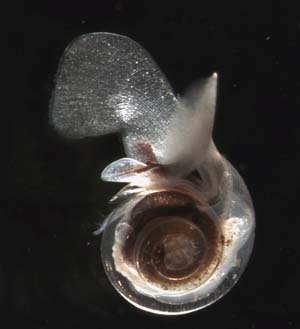| NOAA Magazine || NOAA Home Page |
NOAA / NSF CRUISE REVEALS IMPACTS OF OCEAN ACIDIFICATION ON CHEMISTRY, BIOLOGY OF NORTH PACIFIC OCEAN
 April
5, 2006 � Data collected from ocean sampling in the Pacific Ocean from
the southern to northern hemispheres confirms that the oceans are becoming
more acidic. A recently completed field study from Tahiti to Alaska
collecting data about the effects of ocean acidification on the water
chemistry and marine organisms found evidence that verifies earlier
computer model projections. These findings are consistent with data
from previous field studies conducted in other oceans. (Click
image for larger view of a swimming pteropod, Limacina helicina.
These free-swimming planktonic molluscs form a calcium carbonate shell
made of aragonite. They are an important food source for juvenile North
Pacific salmon and also are eaten by mackerel, herring and cod. Click
here for high resolution version. Photo of pteropod courtesy of Russ Hopcroft, UAF/NOAA.)
April
5, 2006 � Data collected from ocean sampling in the Pacific Ocean from
the southern to northern hemispheres confirms that the oceans are becoming
more acidic. A recently completed field study from Tahiti to Alaska
collecting data about the effects of ocean acidification on the water
chemistry and marine organisms found evidence that verifies earlier
computer model projections. These findings are consistent with data
from previous field studies conducted in other oceans. (Click
image for larger view of a swimming pteropod, Limacina helicina.
These free-swimming planktonic molluscs form a calcium carbonate shell
made of aragonite. They are an important food source for juvenile North
Pacific salmon and also are eaten by mackerel, herring and cod. Click
here for high resolution version. Photo of pteropod courtesy of Russ Hopcroft, UAF/NOAA.)
"We observed measurable decreases in pH, a measure of the acidity of the water, as well as measurable increases in dissolved inorganic carbon over a large section of the northeastern Pacific," said Richard Feely, an oceanographer with the NOAA Pacific Marine Environmental Laboratory in Seattle, Wash., and chief scientist aboard the field study.
The preliminary results from NOAA scientists and their academic colleagues indicate measurable pH decreases of approximately 0.025 units and increases in dissolved inorganic carbon of about 15 µmol/kg in surface waters over a large section of the northeastern Pacific. A lowering of pH indicates rising acidity.
"The pH decrease is direct evidence of ocean acidification in the Pacific Ocean," said Feely. "These dramatic changes can be attributed, in most part, to anthropogenic CO2 uptake by the ocean over the past 15 years. This verifies earlier model projections that the oceans are becoming more acidic because of the uptake of carbon dioxide released as a result of fossil fuel burning."
Feely and his colleagues wrote two papers in 2004 published in the journal Science based on 20 years of ocean observations that indicated the oceans were absorbing vast amounts of carbon dioxide and also the effects that changes in water chemistry would have on marine life such as corals and plankton.
The cruise was part of a decadal series of repeat hydrographic sections jointly funded by the NOAA Office of Global Programs (now the Climate Program Office) and the National Science Foundation Division of Ocean Sciences as part of the Climate Variability and Predictability Study CO2 Repeat Hydrography Program. The cruise aboard the R/V Thomas G. Thompson ended in Kodiak, Alaska, last week.
"The global oceans are the largest natural long-term reservoir for anthropogenic carbon dioxide, absorbing approximately one-third of the carbon dioxide added to the atmosphere by human activity each year. Over the next millennium, the global oceans are expected to absorb approximately 90 percent of all CO2 emitted to the atmosphere," said Christopher Sabine, chief scientist for the first leg of the cruise and an oceanographer at NOAA's PMEL.
Victoria Fabry of California State University-San Marcos and Robert Byrne of the University of South Florida measured the rates of dissolution of the calcium exoskeletons of pteropods, free-swimming planktonic mollusks, subjected to the CO2-enriched waters.
Fabry noted that based on the best available science, it appears that as levels of dissolved CO2 in sea water rise, the skeletal growth rates of calcium-secreting organisms will be reduced as a result of the effects of dissolved CO2 on ocean acidity and consequently, on calcification.
"The effects of decreased calcification in microscopic algae and animals could impact marine food webs and, combined with other climatic changes in salinity, temperature and upwelled nutrients, could substantially alter the biodiversity and productivity of the ocean," Fabry said. "As humans continue along the path of unintended CO2 sequestration in the surface oceans, the impacts on marine ecosystems will be direct and profound."
NOAA, an
agency of the U.S. Department of
Commerce, is dedicated to enhancing economic security and national
safety through the prediction and research of weather and climate-related
events and providing environmental stewardship of the nation's coastal
and marine resources.
Through the emerging Global Earth Observation System of Systems (GEOSS),
NOAA is working with its federal partners, 61 countries and the European
Commission to develop a global network that is as integrated as the
planet it observes, predicts and protects.
Relevant Web Sites
NOAA Pacific Marine Environmental
Lab
Media
Contact:
Kent Laborde, NOAA,
(202) 482-5757
(Photo of pteropod courtesy of Russ Hopcroft, UAF/NOAA)